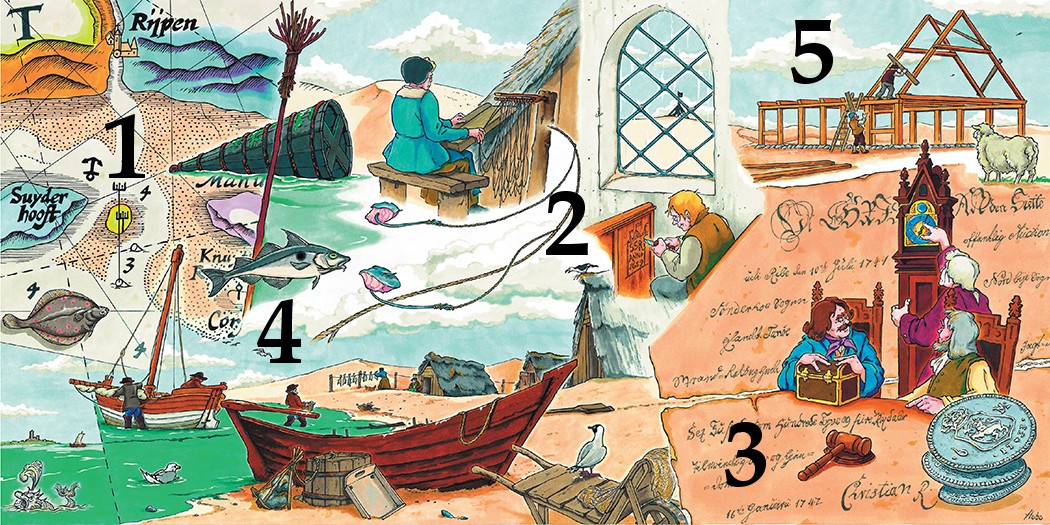
1. In the Renaissance (1536-1650) the fairway into Ribe was well documented in navigation instructions
When you approach Ribe from the south to navigate into Knudedyb or Ribe Dyb, then sail a northerly course passing Rømø and Mandø Shoals towards the south point of Fanø and the Sønderho. Then you’ll see two landmarks or beacons on a sand bar, Peter Meyers Sand, south of Fanø’s southern point. Continue to sail, and when you have the beacons with the innermost (the highest) at about a hand’s breadth north of the outermost (the shortest), and they are nearly in line, they will now be seen in a position towards east or somehow north of you. Now find the outermost fairway buoy, which is laying on four fathoms’ waters off the islands north coast. Keep it to the port side and sail to the next beacon in the directions east and south. When you are by the first beacon you may be able to spot the second.
(The Dutch cartographer Willem Blaeu in his The Light of Navigation, 1612).
2. Graffiti vandalism in Sønderho Church
In Sønderho Church there is a preserved infilling panel from one of the pews in the former Sønderho Church, (demolished and rebuilt in 1782). In the infilling there is a wood carving of three beacons and the initials SSR 1659. May be a teenage boy, with his name hidden in the monogram SSR, had been bored during a church service on a day that many years ago and in between looked out of a south facing window towards the beacon, “Æ Kåver” and fill the time with an incipient seaman’s dreams of call in his mind for going to sea. He then could have cut the beacon and his monogram for the future.
3. Fanø’s Charter of 1741 was obtained by cunning
The Danish King Christian VI (1699-1746) was always in need of money to finance expensive building projects in København for example Christiansborg, and in North Zealand Hørsholm Castle and the Eremitage Hunting Estate. Therefore, the King decided to sell off by auction remote parts of the Crown’s estate including the Island of Fanø.
With reference to the most persistent anecdote the auctioneer on the day of the auction went off for a brief midday nap, and he asked the town hall attendant to call him when the auction should commence.
But the good Fanø resident, Sonnich Jensen, bribed the attendant to set the Town Hall clock one hour ahead. The auctioneer was called, and the auction could begin an hour before the scheduled time, and by luck the Fanø’s residents knocked down at the auction and the business was over and done when one of the most feared competitors, the squire of Trøjborg Manor, appeared but too late. The deed of conveyance was called Fanø’s Charter of Freedom 1741. By this time the residents of Fanø could exercise independent trade, shipping and receiving of wrecks.
4. Sønder Hoved changed from a sandbar to a fishing hamlet
Near the land at Fanø’s south point a channel is meandering into the bigger gully and gradually emerged with a deep called Langdyb (“Æ Dyv”). Here, with shelter from wind and waves, it was an obvious place to establish a fishing hamlet. Fish is a valuable resource today. So was fish also at the time when residents in Ribe in the 1600’s started to exploit the richness of the sea from fishing hamlets in the Wadden Sea. The so called “Sønder Hoved” (South Head) became season after season populated by fishermen from the mainland. Narratives about the legendary herring fishery at Heligoland were present in the fisheries community. The rich fishery became a source of tax assessment (Sand Told), and the Crown got a certain part of it (normally 10 % as so-called “Tiende”). Merchants from Ribe became furious when fishermen from abroad appeared at “Sønder Hoved” and didn’t pay “Sand Told” and undercut fishermen from Ribe. The conflicts often ended in fights and even murder.
5. The fishermen left their huts and built houses
In Sønderho fishing hamlet, nothing went to waste in the fishing seasons. Anything from the catch that couldn’t be used as food for people were spread as fertilizers on small fields. In facts, the fishermen managed over the years to improve the quality of the soil for growing summer rye. But the life in the fishing community was an unequal struggle against sand drift. However, the fishing hamlet prospered, and some families decided to settle in Sønderho. Their fishing boats were mostly built with a flat bottom and open which provided only little protection for the crew in bad weather. Later bigger boats like the “horngjæver” and fishing ewer (“fiskeevert”) became more common.
The timber for housebuilding came from the mainland, and in the beginning most houses were timber framed and built northwest of the natural harbour for fishing boats. The place was called “Æ by” (really a small settlement). In about 1700 many fishermen in Sønderho changed their living from fishing to local shipping. At the same time the village expanded south towards what is now the main Sønderho called “Æ land” (Landet).
English translation by Palle Uhd-Jepsen and Rosemary Mason, 2023
Kontakt redaktøren
Skriv gerne til hjemmesidens redaktør
med forslag til forbedringer.
Sidst opdateret 11. maj 2025
Kontakt foreningen
Sønderho Havn Støtteforening
Formand Brian Schmidt Nielsen
Tlf.: 21 68 00 80
Mail: info@sonderhohavn.dk